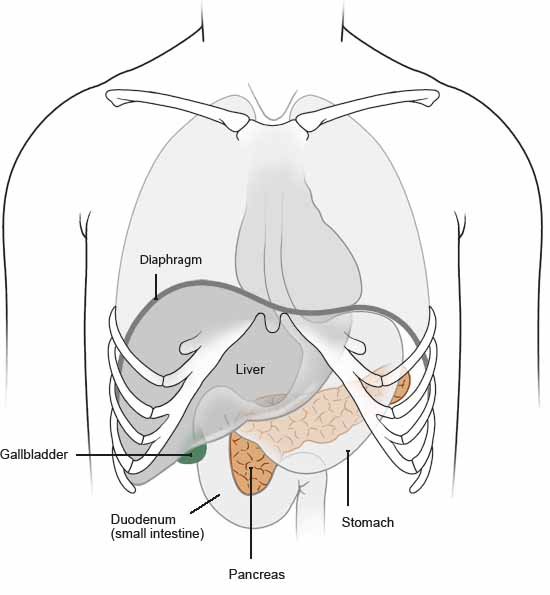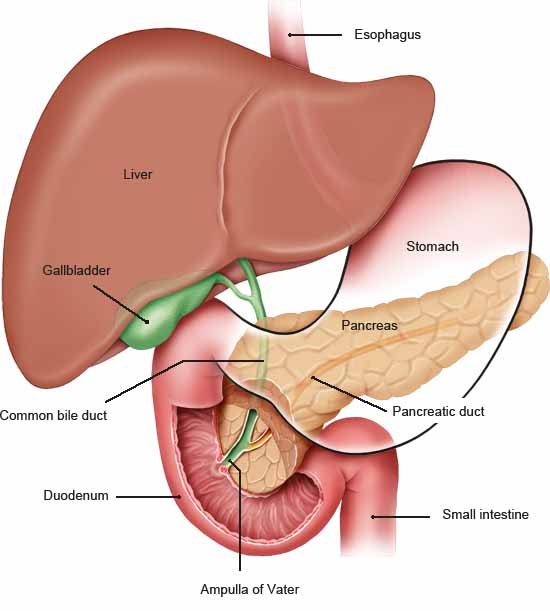The exocrine cells of the pancreas
The exocrine cells produce digestive juices – about 1.5 to 2 liters per day. They are called exocrine ("secreting outside") because the digestive juices that they produce flow out into the small intestine rather than directly into the bloodstream. This clear, colorless fluid is mainly made up of water and also contains salt, sodium bicarbonate and digestive enzymes. There are three main types of enzymes:
- Lipases to break down fats
- Proteases to break down proteins
- Amylases to break down carbohydrates
The digestive juices that are made in the pancreas flow into the small intestine through a tube known as the pancreatic duct. In most people, this duct is joined by a similar duct coming from the gallbladder (the bile duct) before it reaches the small intestine. There is a circular muscle (sphincter) at the shared opening of the two ducts. This muscle controls the release of the digestive juices into the small intestine.
The endocrine cells of the pancreas
Groups of endocrine cells are found throughout the pancreas. They are called islets of Langerhans because they are scattered like small islands (“islets”) and were discovered by the pathologist Paul Langerhans. These groups of cells produce insulin, glucagon and other hormones. They are called endocrine ("secreting internally") cells because the hormones that they produce are secreted directly into the blood. These hormones usually help to regulate blood sugar levels, stopping them from getting too high or too low.
When the blood sugar levels rise, as they do after a meal, insulin is released by the islets of Langerhans. This hormone helps sugar to be absorbed from the bloodstream into the cells of the body. Insulin also allows the liver and the muscles to store sugar, as well as keeping the liver from producing more sugar. This lowers your blood sugar levels.
When blood sugar levels are too low, the pancreas releases glucagon into the bloodstream. This hormone does the opposite of what insulin does: It causes the liver cells to release stored sugar. It also makes sure that proteins in the liver are turned into sugar that can then be used for energy. If the blood sugar levels rise, the release of glucagon is stopped.
Brandes R, Lang F, Schmidt R (Ed). Physiologie des Menschen: mit Pathophysiologie. Berlin: Springer; 2019.
Menche N (Ed). Biologie Anatomie Physiologie. München: Urban und Fischer; 2016.
Pschyrembel. Klinisches Wörterbuch. Berlin: De Gruyter; 2017.
IQWiG health information is written with the aim of helping people understand the advantages and disadvantages of the main treatment options and health care services.
Because IQWiG is a German institute, some of the information provided here is specific to the German health care system. The suitability of any of the described options in an individual case can be determined by talking to a doctor. informedhealth.org can provide support for talks with doctors and other medical professionals, but cannot replace them. We do not offer individual consultations.
Our information is based on the results of good-quality studies. It is written by a team of health care professionals, scientists and editors, and reviewed by external experts. You can find a detailed description of how our health information is produced and updated in our methods.
Stay informed
Subscribe to our newsletter or newsfeed. You can find our growing collection of films on YouTube.


